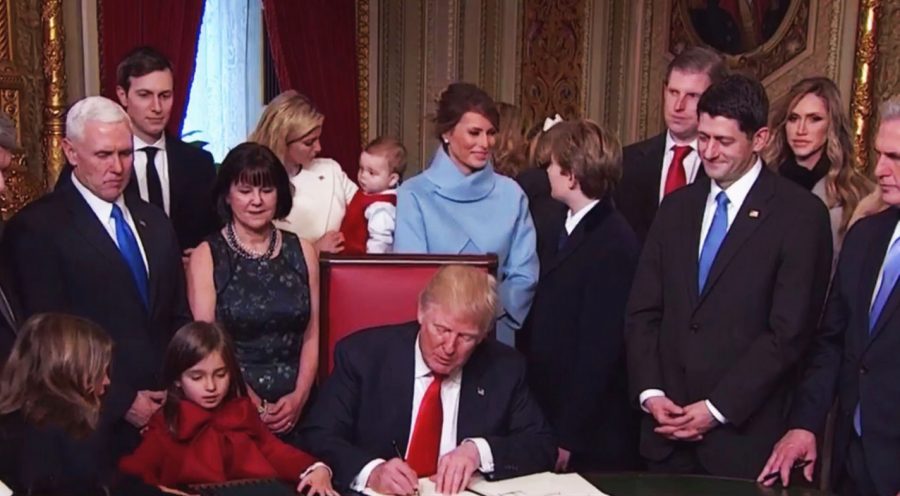Trump administration wastes no time with executive orders
Trump gains media attention by signing 22 executive orders in first 14 days
February 10, 2017
In every presidency, the first 100 days are known to be the most momentous in shaping the President’s focus for the next four years.
As week three of the Trump administration comes to a close, President Trump has already hit the ground running with a flurry of executive actions that define what America can expect from him for the next four years.
As of Feb. 7, Trump has signed 22 executive actions, some more publicized than others.
In terms of how this number compares to past presidencies, AP Political Science teacher Alex Zilka said, “It’s typical for a President to issue executive orders when they come into office. I think what has been unusual about this presidency is the number of executive orders has been more than past administrations in the first couple weeks.”
President Barack Obama signed 19 executive orders in his first 100 days as president.
The content of these orders, “Are dealing more with partisan, more polarizing, and more sensitive issues than we’ve seen in the past,” said Zilka. “Typically, the executive orders people issue in the first couple weeks are often dealing with bureaucratic management and small types of issues that don’t really receive a lot of public attention,” he stated.
Trump’s first executive order was signed on the day of his inauguration, and paved the way to repeal the Affordable Care Act, also known as Obamacare. Speaker of the House Paul Ryan later made a statement on the issue, stating that a plan to replace the ACA will be developed before it is repealed.
Trump’s first order to catch media attention was signed on Jan. 24, and approved building the Keystone XL and Dakota Access Pipelines.
The order required that all materials for future pipelines be manufactured in the United States. The construction of the Dakota Access Pipeline has been under scrutiny for the past few months because of its proximity to the land of the Sioux tribe. Its building was halted by President Obama in his last month in office.
On Jan. 25th, the Trump administration attracted media attention after signing an executive order to cut funding to sanctuary cities, which are cities that choose not to prosecute illegal immigrants for violating federal immigration laws.
The text of the order declares its purpose is, “to ensure the public safety of the American people in communities across the United States.”
Some sanctuary cities, including San Francisco, have begun suing Trump over the order, claiming it to be unconstitutional.
Trump’s most publicized order yet was signed on Jan. 27, titled “Executive Order protecting the nation from foreign terrorist entry into the United States.”
The order placed a ban on people from 7 majority-Muslim countries from entering the U.S. for 90 days, except for Syria, which is banned for an indefinite amount of time.
The barred countries are Iran, Iraq, Libya, Somalia, Yemen, and Syria.
On Feb. 3, U.S. District Court Judge James Robart suspended the ban, declaring it unconstitutional. This decision was taken to the The Ninth Circuit Court of Appeals for review.
On Sunday, the court denied the U.S. government’s emergency request to resume with the ban. The circuit court asked both sides to file briefs before a decision is made.
Along with executive orders, the first 100 days mark the period of determination for the makeup of the federal government’s 15 different executive departments. For these departments, there are nearly 700 positions that require a nomination from Trump and a confirmation from the Senate. As of Feb. 7, there are 657 positions awaiting nomination, 28 awaiting Senate approval, and seven that have already been confirmed.
As of Feb. 7, the confirmed department secretaries are Rex Tillerson for Secretary of State, General Jim Mattis for Department of Defense, General John F. Kelly for Department of Homeland Security, Elaine Chao for Department of Transportation, Michael Pompeo for the Director of the Central Intelligence Agency, and Betsy Devos for Secretary of Education
Additionally, Nikki Haley has been confirmed as the U.S. representative to the United Nations.
In addition to bureaucratic nominations, on Jan. 31, President Trump put forth a nomination to fill the ninth seat of the Supreme Court. The seat has been vacant since late Justice Antonin Scalia’s death on Feb. 13, 2016. To take Scalia’s place, President Trump nominated Neil Gorsuch, who is currently a judge on the United States Court of Appeals for the Tenth Circuit.
If confirmed, Gorsuch, 49, will become the youngest justice to ever serve.













































